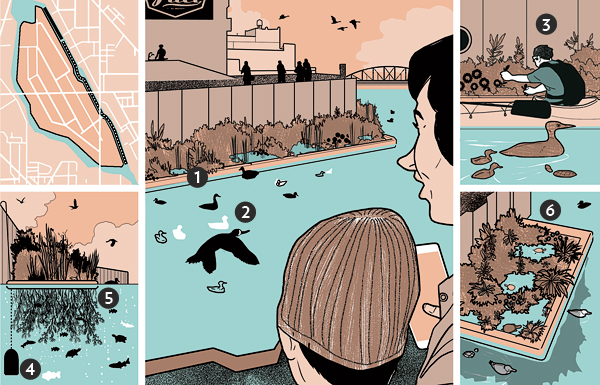Of stuff that’s historically lived in the Chicago River (garbage, fecal matter … we won’t go on), lush plant life and thriving critters don’t top the list. Local nonprofit Urban Rivers is on a mission to change that. Its secret weapon? Floating gardens.
The idea goes like this: Water nourishes plants, plants (and the insects they attract) feed fish, fish bring animals, the circle of life flourishes, and a bleak waterway gets a revitalizing face-lift that woos pedestrians and kayakers.
In 2013, Urban Rivers built a 5-by-10-foot pilot garden that drew seven kinds of fish and produced a cherry tomato harvest—a promising start. A Kickstarter campaign has since raised nearly $30,000 to transform a half-mile stretch of river with floating gardens on the east side of Goose Island by 2020.
The first 160-plus feet will be installed this month. Here’s a closer look.

1. Floating Structures
Designed by Biomatrix Water, the eight-inch-thick floats are made of coir (the fibrous middle layer of a coconut), which is buoyant, permeable, and conducive to certain kinds of good bacteria, says Urban Rivers cofounder Nick Wesley.
2. Wildlife
As the plants and fish (from bluegill to largemouth bass) thrive, a miniature ecosystem will develop and attract other wildlife, such as great blue herons, mallard ducks, crayfish, toads, dragonflies, mussels, minks, and maybe even otters.
3. Upkeep
Volunteers in kayaks will maintain the gardens and track plant growth, while stationary cameras will document animal visitors.
4. Anchors
Weighted cables will attach the floating platforms to the top of the river wall, allowing the gardens to match the ebb and flow of the water while staying in place.
5. Submerged Roots
The gardens don’t use soil because the river already has high levels of nitrogen and phosphorus, key nutrients for the native Illinois plants atop the floats. Their roots will stretch beneath the water’s surface, where fish will nibble at them.
6. Turtle Pools
Some floats will have hollow centers, like tiny lagoons, to attract turtles.


